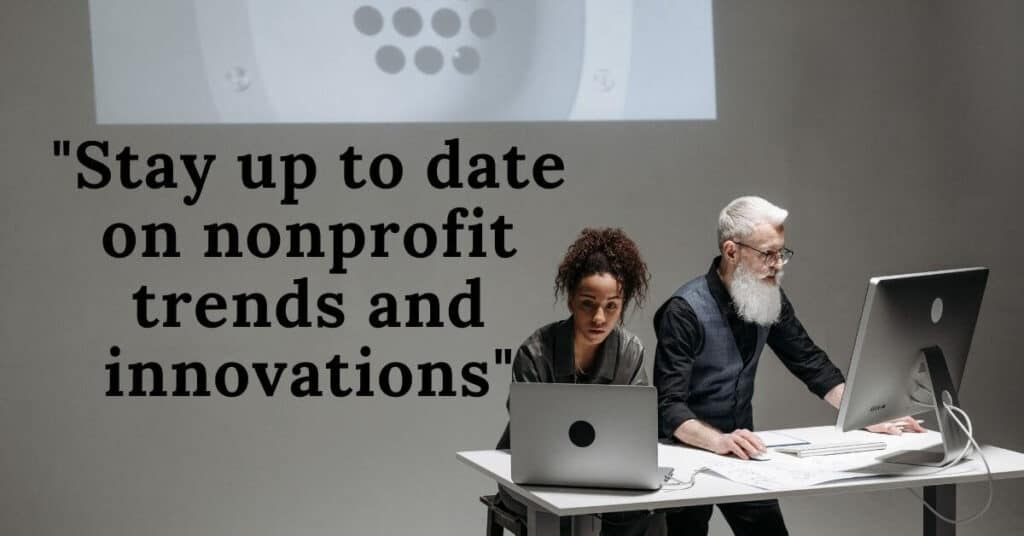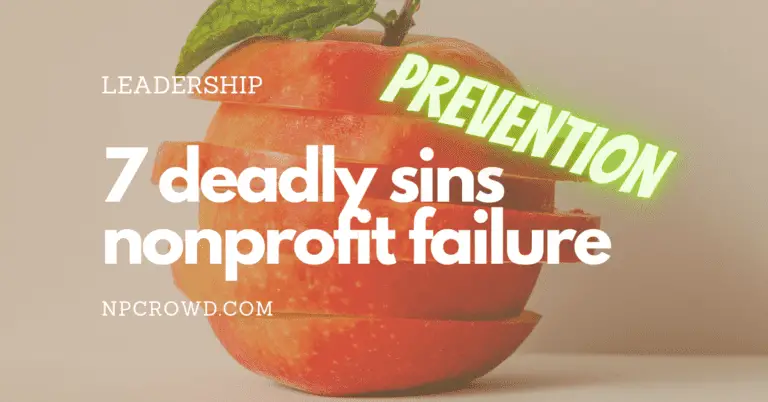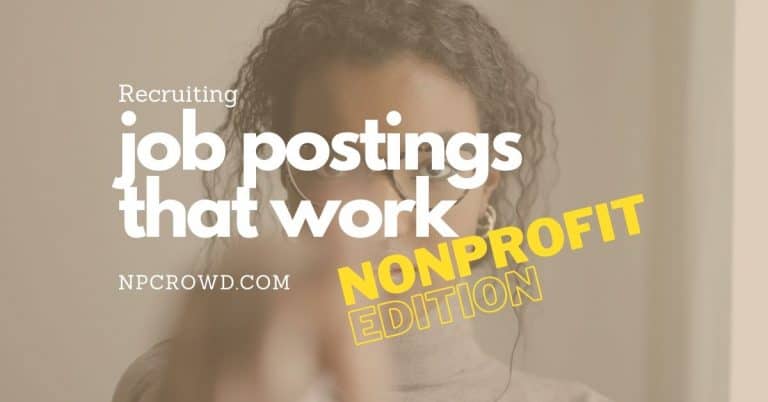21 Ideas To Improve Your Nonprofit
Disclaimer: This post may contain affiliate links. These links, if used and purchases made, we may earn a small commission. These affiliate programs do not impact the recommendations we make or the resources we refer you to. Our focus is on providing you the best resources for your nonprofit journey.
In order to make a nonprofit organization better, it is important to first understand what areas need improvement.This can be done through reviews and contemplation. By understanding what works and what doesn’t, those running a nonprofit can make changes that will lead to a more successful organization.
Below are 21 ideas to help make a nonprofit organization better.
1. Collaborate with other nonprofits to create a stronger community impact

Collaborating with other nonprofits is a great way to create a stronger community impact. By working together, organizations can share resources, ideas, and volunteers. This can help improve communication and efficiency, and ultimately lead to a bigger impact on the community.
There are many benefits to collaborating with other nonprofits.
First, it can help organizations save money by sharing resources. Second, it can improve communication between organizations, which can lead to better collaboration and more effective programs. Third, collaborating with other nonprofits can help increase awareness of each organization’s work.
And finally, collaborating with other nonprofits can build relationships and partnerships that can be beneficial in the future.
2. More Effective Nonprofit Marketing & Fundraising Through Data and Analytics

Nonprofits are always looking for new and innovative ways to market themselves and raise money. However, many organizations struggle to effectively use data and analytics to guide their efforts. By understanding which marketing and fundraising strategies are most effective, nonprofits can make the most of their resources and achieve better results.
One way data and analytics can be used effectively is by segmenting donors and prospects. This allows nonprofits to target their marketing and fundraising messages more effectively, and ultimately improve results. Additionally, data and analytics can be used to identify which channels are most effective for marketing and fundraising. This allows nonprofits to focus their efforts on the channels that are most likely to result in donations.
Ultimately, data and analytics can help nonprofits improve their marketing and fundraising efforts by providing insights into what strategies are most effective. By understanding which strategies work best, nonprofits can improve their chances of success and make the most of their resources.
3. Implement Innovative Technologies to Streamline Nonprofit Operations and Reduce Costs

In order to remain sustainable, nonprofit organizations need to be strategic in how they allocate their resources. One way to reduce costs is by implementing innovative technologies that streamline operations. For example, a cloud-based accounting system can help manage finances and donations more efficiently.
Alternatively, a customer relationship management (CRM) system can help track interactions with donors and volunteers.
Now, think beyond the common tools and think about other true innovations in your nonprofit program space or better yet, in other for-profit markets where the innovation could be applied in to the social change area you serve. Some of the greatest innovations in one market came from another market and simply took someone seeing seeing how it could be used.
By utilizing these types of technologies, nonprofits can save time and money while still providing high-quality services to their constituents.
The book Loonshots, by Safi Bahcall, gives several large scale examples. (Amazon)
4. Create a social media strategy to engage supporters and spread your message

In order to create an effective social media strategy, it is important to understand how social media works and how it can be used to engage your supporters and spread your message. Social media provides a way for organizations to communicate with their supporters in a way that is interactive and engaging. Organizations can use social media to share news and updates, solicit feedback, and raise money.
To create an effective social media strategy, you need to identify your goals and objectives and develop a plan that will help you achieve them. You also need to identify the right social media platforms for your organization and create content that will interest your supporters. You should also consider using paid advertising to reach more people.
Organizations that are successful with social media take the time to engage with their supporters and create interesting content that will keep them engaged. This is an investment that has a cost but can also have a high Return On Investment (ROI).
5. Develop a corporate partnership program to get businesses involved in your cause

Developing a corporate partnership program is a great way to get businesses involved in your cause. By creating a formalized partnership agreement, both the business and the nonprofit can agree to specific terms and conditions that will help support the nonprofit’s mission while also benefiting the business.
Some benefits of corporate partnerships include marketing and PR opportunities, employee engagement, and financial support.
To develop a successful corporate partnership program, the nonprofit should first identify businesses that share its values and have similar goals. Once potential partners have been identified, the nonprofit should reach out to them with a proposal that outlines what it is looking for in a partnership and provides examples of how the two organizations could work together.
It’s important to keep in mind that not all businesses will be interested in partnering with nonprofits, so don’t be discouraged if there is not an immediate response.
6. Hold events and fundraisers to raise awareness and funds for your nonprofit

One of the most important things a nonprofit can do to raise awareness and funds is to hold events and fundraisers. Events can be as simple as a small gathering of friends or as large as a major city-wide celebration.
Whatever the size, events provide a great opportunity for your nonprofit to connect with potential donors and volunteers, share what you’re doing, and raise money.
Fundraisers can be just as varied as events. They can be online campaigns, auctions, or even bake sales. The important thing is to think creatively about how you can raise money from the people who care about your cause.
Events and fundraisers are a great way to connect with potential donors and volunteers. They also provide a great opportunity to share what you’re doing and raise money. Keeping your organization’s name and mission constantly in the public’s eye provides an opportunity for awareness building of the need and your organization’s existence to fill that need.
7. Create a volunteer program to get people involved in your cause

One of the best ways to get people involved in your cause is to create a volunteer program. This will give people the opportunity to help out in whatever way they can. There are many different ways to set up a volunteer program, so it’s important to tailor it to fit your needs. Here are some tips on how to create and run a successful volunteer program:
- Start by recruiting volunteers. You can do this by putting out a call for volunteers on your website or social media pages, or by sending out an email blast. Be sure to include information about what kind of tasks volunteers will be performing and what kind of commitment is required.
- Create a system for tracking volunteer hours. This will help you keep track of how much work volunteers are doing and ensure that everyone is getting credit for their efforts.
- Encourage volunteers to get to know one another. This will not only help you recruit more volunteers, but it will also make your volunteer program more enjoyable and productive.
- Make it clear that you are here to help your community, not just use them as free labor.
- Ensure that all volunteers are treated with respect and courtesy.
- Offer incentives for volunteering, such as free tickets or VIP passes to special events. 7. Provide support, training, and resources as you implement your volunteer program.
8. Advocate for policy changes at the local, state, and federal level to support your mission

In order to achieve your mission, you will need to advocate for policy changes at the local, state, and federal level. You can start by talking to your local officials and explaining how the policies they enact could help or hinder your work.
If you have a relationship with your state legislators, you can also talk to them about how they can support your mission. Finally, you can reach out to your federal representatives and ask them to pass legislation that would benefit your cause.
“As an organization dedicated to ending homelessness, we advocate for policy changes at the local, state, and federal level that would support our mission.
For example, at the local level, we work with city officials to ensure that zoning laws are not making it difficult for us to build homeless shelters. We also advocate for policies that would provide more funding for homeless services, and we work to increase public awareness about the issue of homelessness.
At the state level, we lobby for legislation that would provide more funding for homeless services and housing. We also work with state officials to ensure that laws and regulations are not making it difficult for us to provide services to those who are homeless.
Finally, at the federal level, we lobby for legislation that would provide more funding for homeless services and housing.”
9. Collaborate with other nonprofits and businesses to create social impact projects

In order to maximize social impact, nonprofits should collaborate with other nonprofits and businesses. This type of collaboration can take many forms, such as working together on a project or sharing resources. By collaborating, organizations can pool their resources and expertise to create more meaningful projects.
Additionally, collaborating with others can help build relationships and networks that could lead to future partnerships. As these partnerships and shared goals and accountability mature, look into creating a collective impact alliance to solve BIG issues together.
10. Write grants to secure funding from foundations and other organizations

Grants can be a great way to secure funding for your organization. They can also be a great way to fund specific programs or projects.
There are many different types of grants available, and each one has its own set of requirements. It’s important to do your research before you apply for a grant, so you know what is required and how to best present your proposal.
Look at capacity-building grants to mature your organizations. Look into the grants available through federal agencies; this is usually a little more difficult to secure, but it may be worth the extra effort.
11. Create a marketing campaign to raise awareness of your nonprofit and its mission

Creating a marketing campaign to raise awareness of your nonprofit and its mission can be a daunting task. However, by using some simple tips, you can create an effective and successful marketing campaign.
To start, you should identify your target audience and craft your message specifically for them. You should also consider how you will reach your target audience—through social media, email, print materials, or advertising?
Once you have determined these things, it’s time to get creative! Use eye-catching visuals and powerful slogans to capture people’s attention. And be sure to keep your messaging consistent across all of your marketing materials.
Finally, make sure to track the results of your campaign so that you can evaluate its effectiveness and make necessary adjustments.
12. Implement an impact measurement system to track your nonprofit program progress and impact

In order to track the progress and impact of your nonprofit program, you need to implement an impact measurement system. This system will help you gather data on how well your program is meeting its objectives and what changes, if any, need to be made.
There are a number of different impact measurement systems available, so choose one that best suits your needs. Common systems of nonprofit program evaluation include :
- Activity-Based Costing (ABC)
- Cost-Benefit Analysis (CBA)
- Impact Analysis (IA)
You can also choose to use a combination of systems.
Once you have selected a system, make sure everyone involved in the program is familiar with it and how to use it. Then, begin collecting data! This information will help you track the progress of your program and determine its impact on those it serves.
Don’t forget to begin including evaluation data in your annual report and marketing efforts!
13. Conduct research to develop new nonprofit programs and services to better meet the needs of your target population

Poets often talk about the need for their work to speak to the times, and nonprofits are no different. The more clearly you are able to define the problem your organization is trying to solve, the more likely you are to develop programs that effectively meet people’s needs. This is where research and analysis come into play.
If your organization is not already conducting research, consider hiring an outside consultant to help you develop a research plan.
A good way to begin this process is to review and evaluate the programs and services currently in place at your organization. What are the strengths and weaknesses of those programs? Where are your people most engaged? What do you need to strengthen or improve?
Once you have a better idea of what is working, it’s time to think about how to expand and deepen that work.
14. Build coalitions with like-minded organizations to amplify your voice and reach

One of the most important things you can do as an activist is to build coalitions with like-minded organizations. When you band together with others, you can amplify your voice and reach more people. This also allows you to share resources and ideas, and to work together on campaigns.
There are many different types of coalitions that you can form. You might want to join forces with a group that shares your issue area, or with an organization that has a similar mission. Another option is to form a coalition of groups from different parts of the country or world, who can come together to share strategies and support each other.
One example is Nonprofit Cyber, which is a coalition of cybersecurity nonprofits focused on implementation. The coalition has been formed to collaborate, work together on projects, voluntarily align activities to minimize duplication and increase mutual support, and link the community to key stakeholders with a shared communication channel.
Whatever type of coalition you choose to form, it’s important to make sure all of the members are committed to working together towards common goals. This takes time and effort, but it can be incredibly effective in achieving change.
15. Develop a website and online presence to reach more people

There are many benefits to having a website and online presence. For starters, it allows you to reach more people. A website is a great way to showcase your work, and it also provides a place for people to learn more about you and your business. Additionally, a website can help you connect with potential clients and customers.
Having an online presence is also a great way to build brand awareness. But, we are not talking about a website that your second cousin’s 16-year-old niece made for you. Hire it out with an agency that can blend who you are with your marketing strategy and plan. By creating a strong online presence, you can connect with more people and grow your business.
Learn more about nonprofit branding by reading Do More Good. It’s the bible of nonprofit branding!
16. Use storytelling to engage people with your cause and create emotional connections

Storytelling is a powerful way to connect with people and engage them in your cause. It can create an emotional connection that helps people feel invested in what you are doing.
When you tell a story, you can put a human face on the issue you are working to address, making it more relatable and compelling. Additionally, storytelling can be used to inspire people to take action and get involved in your work.
A word to the wise: Honor those you serve by not turning them into hopeless heart strings for funding, but rather let them inspire donors to engage.
17. Create a sustainable business model to ensure long-term success and sustainability of your nonprofit

In order for a non-profit to be successful in the long term, it is important to have a sustainable business model. This means that the organization’s revenue and expenses must be in balance, and it should be able to continue operating even if donations or grant funding decreases.
There are many different ways to create a sustainable business model for a non-profit. One option is to charge fees for services provided. Another approach is to generate revenue through fundraising events or by selling merchandise.
It’s also important to keep expenses low and find ways to reduce or eliminate waste. But that doesn’t mean scrimping on compensation and benefits.
You will also want to look at 6 months of operating reserves and a plan to get there.
18. Train staff and volunteers to be effective ambassadors for your organization

An organization’s success often depends on the quality of its ambassadors – the people who represent it to the public.
Train staff and volunteers to be effective ambassadors for your organization by providing them with clear messaging, appropriate tools, and adequate training. This will help them feel confident in their ability to represent your organization positively and accurately.
And don’t forget your board members. Train and then hold your board accountable to be advocates for the work of your nonprofit. Have them commit to filling a table at big events.
19. Mobilize supporters to take action on your behalf

In order to get the help you need, it’s important to mobilize your supporters (PDF). Start by drafting a letter or email template that you can send out to your network of friends, family, and colleagues. The email should explain what’s happening and why they should take action.
It’s also important to provide specific instructions on what they can do to help (e.g., sign a petition, call their congressman, etc.). You can even create a social media campaign using hashtags to help spread the word.
Whatever you do, make sure you’re providing people with clear ways to take action and make a difference.
20. Stay up to date on trends in the nonprofit sector and adapt your strategies accordingly

The nonprofit sector is constantly evolving with new trends and strategies. It is important for organizations to stay up to date on the latest trends and adapt their strategies accordingly.
Some of the latest trends in the nonprofit sector include using data to make decisions, using technology, and creating partnerships. Organizations that fail to stay up to date on these trends may find themselves struggling to compete in the current environment.
Some current technology trends include the use of Artificial Intelligence (AI), chatbots, sentiment analysis, and new translation tools for deaf and blind communities.
21. Diversify your nonprofit funding sources to ensure long-term sustainability

In order for a nonprofit to be sustainable in the long run, it is important to diversify its funding sources. This means that the organization should not rely too heavily on any one source of income, but should instead spread its funding sources out among different donors, grants, and programs. This will help to ensure that the nonprofit is not as vulnerable to changes in the economy or in government funding policies.
There are a number of ways for a nonprofit to diversify its funding sources. One way is to build relationships with individual donors, who can contribute money on an ongoing basis. Another way is to seek out grants from private foundations and government agencies.
The organization can also earn revenue by providing goods or services to the community. Finally, the nonprofit can raise money through special events and fundraising campaigns.
Wrap Up
In conclusion, there are many ways that a nonprofit organization can become better. By implementing new innovations, running effective campaigns, and forming partnerships with other organizations, a nonprofit can reach its goals and improve the lives of those it serves.
Which ideas were you favorite? Let us know below.







